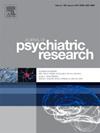Lethality and recidivism in suicide Attempters: A longitudinal study
IF 3.7
2区 医学
Q1 PSYCHIATRY
引用次数: 0
Abstract
Background
Lethality (or medical severity) and recidivism in suicide attempts are of particular interest due to their impact on clinical decision-making and associated risks. However, current literature has yet to clarify the relationship between recurrence and lethality.
Aim
This study examines the relationship between lethality and recidivism in suicidal behavior and their combined impact on mortality.
Methods
A longitudinal study was conducted on a cohort of 1206 individuals who had attempted suicide. Sociodemographic and clinical data—including lethality, reattempts, and mortality—were collected, with a minimum follow-up period of 5 years. Logistic regression was used to analyze associations between high lethality (>48 h of medical care), frequent reattempts (≥5), and death (suicidal and non-suicidal).
Results
High lethality was found in 28.3 % of patients, and 18.2 % were frequent reattempters. Risk factors for frequent reattempts, in decreasing order, were having an eating disorder, being female, having a substance use disorder, and high lethality. In contrast, personality disorder appeared to be protective compared to the overall sample of attempters. Factors linked to high-lethality attempts were a history of recidivism, frequent reattempts, and older age. Suicidal death risk was associated with high lethality, psychotic disorders, and older age. No correlation was found between the total number of reattempts and maximum lethality.
Conclusions
High lethality in suicide attempts is associated with frequent reattempts and higher mortality risk, highlighting the need for targeted interventions, particularly for those with repeated attempts and high-lethality behaviors. Screening for physical comorbidities in high-lethality patients is critical to reduce non-suicidal mortality.
自杀未遂者的致死率和累犯率:一项纵向研究
背景自杀企图的致命性(或医学严重性)和累犯性由于其对临床决策和相关风险的影响而受到特别关注。然而,目前的文献尚未阐明复发与致死率之间的关系。目的探讨自杀行为中致死率与累犯率的关系及其对死亡率的影响。方法对1206名自杀未遂者进行纵向研究。收集社会人口学和临床数据,包括致死率、再尝试率和死亡率,随访时间至少为5年。采用Logistic回归分析高致死率(住院48小时)、频繁再尝试(≥5次)和死亡(自杀和非自杀)之间的关系。结果28.3%的患者死亡率高,18.2%的患者多次再尝试。频繁再尝试的风险因素依次为饮食失调、女性、物质使用障碍和高致死率。相比之下,人格障碍似乎对所有企图者都有保护作用。与高致命性企图相关的因素是累犯史、频繁再犯和年龄较大。自杀死亡风险与高致死率、精神障碍和年龄较大有关。再尝试总次数与最大致死率之间没有相关性。结论自杀未遂的高致死率与频繁的再尝试和较高的死亡风险相关,强调需要有针对性的干预措施,特别是对那些多次尝试和高致死率行为的人。筛查高致死率患者的身体合并症对于降低非自杀死亡率至关重要。
本文章由计算机程序翻译,如有差异,请以英文原文为准。
求助全文
约1分钟内获得全文
求助全文
来源期刊

Journal of psychiatric research
医学-精神病学
CiteScore
7.30
自引率
2.10%
发文量
622
审稿时长
130 days
期刊介绍:
Founded in 1961 to report on the latest work in psychiatry and cognate disciplines, the Journal of Psychiatric Research is dedicated to innovative and timely studies of four important areas of research:
(1) clinical studies of all disciplines relating to psychiatric illness, as well as normal human behaviour, including biochemical, physiological, genetic, environmental, social, psychological and epidemiological factors;
(2) basic studies pertaining to psychiatry in such fields as neuropsychopharmacology, neuroendocrinology, electrophysiology, genetics, experimental psychology and epidemiology;
(3) the growing application of clinical laboratory techniques in psychiatry, including imagery and spectroscopy of the brain, molecular biology and computer sciences;
 求助内容:
求助内容: 应助结果提醒方式:
应助结果提醒方式:


